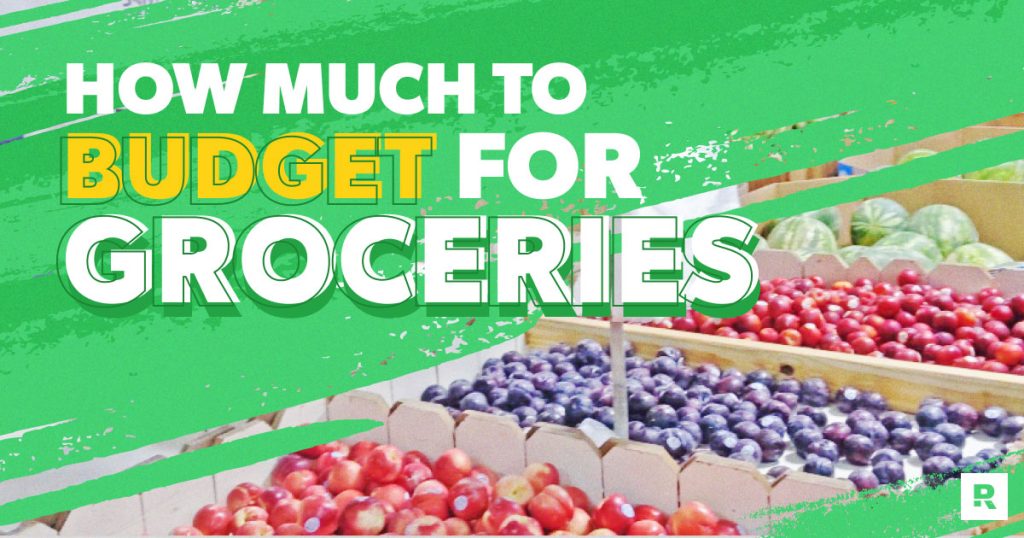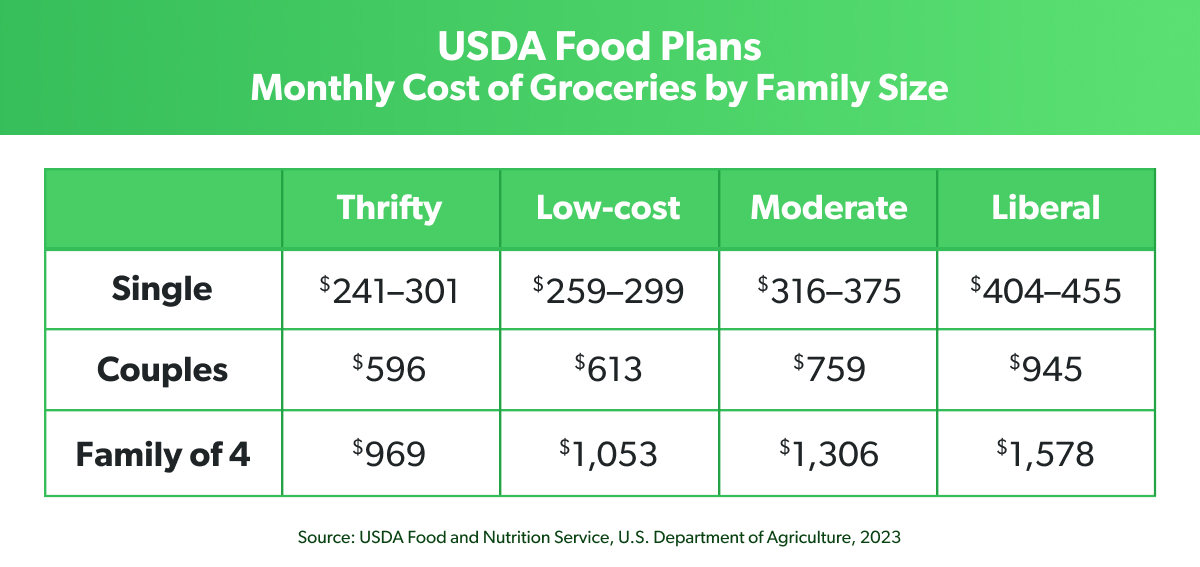When setting up your budget, it’s hard to know how much money to set aside for the essentials—like food. Exactly how much should you spend on groceries each month?
Well, it depends. Income, family size, dietary restrictions and lifestyle all affect your monthly grocery budget.
Average Cost of Groceries Per Month
The average household grocery cost per month is $475—which totals to $5,703 a year.1
And that number is likely to increase as overall food prices continue to go up. In fact, Americans spent 1.3% more on food at home (aka groceries) in December 2023 than they did in December 2022.2 And that doesn’t even include how much people also spend eating out each month!
But depending on where you live, what grocery store you shop at, and what you put in your cart, you could spend more or less than the average grocery cost. So, let’s talk about how to set a monthly grocery budget that makes sense for you.
How Much to Spend on Groceries Each Month
Unfortunately, there’s no magic number for what each family should spend on groceries.
The USDA Food Plans and Cost of Food Reports give a rough estimate of what you could spend on groceries. These plans are based on current food prices and are broken down into four different budget levels: Thrifty, Low-cost, Moderate and Liberal. (Keep in mind, these numbers don’t represent how much people are actually spending on groceries each month.)
Single-Person Household
- Thrifty Plan: $241–301
- Low-cost Plan: $259–299
- Moderate Plan: $316–375
- Liberal Plan: $404–455
Couple (Family of Two)
- Thrifty Plan: $596
- Low-cost Plan: $613
- Moderate Plan: $759
- Liberal Plan: $945
Family of Four (With Two Children, Ages 6–8 and 9–11)
- Thrifty Plan: $969
- Low-cost Plan: $1,053
- Moderate Plan: $1,306
- Liberal Plan: $1,578 3,4
How to Set Up Your Grocery Budget
Everyone’s grocery budget is going to look different. But here are the steps to figure out how much you should spend on groceries each month.
1. See what you already spend.
Start by opening up your bank account. Then, go through your spending history and add up how much you spent on groceries each month for the last several months. Use the monthly average as your baseline amount. You may cringe when you see the total, but knowing how much you actually spend each month will help you create a budget that makes sense for you and your family.
2. Budget for other expenses.
Once you decide on a number for your grocery budget, finish setting up the rest of your budget. What are your other monthly expenses? After food, make sure you cover the other Four Walls of housing, utilities and transportation. Do you pay for day care? What about subscriptions? Oh, and don’t forget any debt you may have—like car payments, credit card bills or student loans.
3. Adjust as needed.
Once you’ve included all your expenses in your budget, you might need to do some adjusting. Your goal is to give every dollar a job—whether you’re giving it, saving it, using it to pay off debt or spending it. That’s what we call a zero-based budget. You also want to make sure you’re not spending more than you make each month. So, go back through your budget and see which areas you can cut back on (maybe food) and where you can put more money (toward savings, for example).
![]()
Try our free Meal Planner to save money on groceries!
And listen, you probably won’t get your grocery budget right for the first few months. If you keep going over because you can’t feed your family with the amount you originally set, it’s okay to bump that number up. But if you keep going over budget because you can’t get your spending under control, you need to make some different choices or find ways to save money (more on that in a minute).
4. Consider your financial goals.
Food is usually one of the biggest areas we overspend on, but it can also be one of the biggest opportunities to help you save money and hit your goals!
For example, if you’re paying off debt, focus on throwing as much money as you can toward your payments. So, you might prioritize shopping for cheaper meals that require less ingredients to help you cut costs. Or maybe you decide to stop eating out entirely. In that case, your grocery budget probably needs to be a little bigger because you’ll be cooking at home more.
If you’re trying to rebuild your emergency fund, your grocery budget will probably look a little lean for a couple of months while you stockpile some savings. Or maybe you’ve got the room in your budget to add those expensive cheeses to your cart without it derailing your progress. Whatever your goal, your grocery budget can play a huge part in how fast you get there!
How to Lower Your Grocery Costs
Setting a grocery budget for the month is the best way to spend less. Because when you give yourself a limit before you head into the store, you’re more likely to shop responsibly (instead of just throwing things in a cart and saying a quick prayer at checkout).
But how do you stick to your grocery budget? Thankfully, there are plenty of ways to save money on groceries!
Raid Your Pantry and Fridge First
Before you rush off to the grocery store, take a good look through your pantry and fridge. Maybe you forgot you already have a jar of mayonnaise for that recipe. Or you could use those peppers that are about to go bad to make fajitas. Just take inventory and get creative with some pantry recipes. Waste not, want not, right?
Change Up Where You Shop
One of the biggest factors in how much you spend on groceries is where you shop. Seriously, have you seen the price differences out there? Check out some cheaper grocery stores in your area—like Costco, Aldi and Walmart. Yeah, you may have to bag your own groceries or pay a quarter to use a shopping cart at some of these places, but that little bit of inconvenience means huge savings for you!
Choose Generic
According to a Consumer Reports study, store brands cost anywhere from 5–72% less than name brands—and most of them taste just as good as the name brand.5 Even if you aren’t willing to trade in your Cheerios for Honey O’s just yet, start by opting for the generic brand of basics like condiments, bread, yogurt, nuts or soup. You probably won’t notice the taste difference, but you’ll definitely notice the price difference on your receipt!
Shop Sales
Another way to save money on your next grocery store run is to pay attention to sales. Do your research beforehand to scout out any weekly specials and try to plan your meals around those items. Shopping produce that’s in season can also save you some bucks.
And if you’ve got the time and patience, you can always try couponing. Just don’t forget to do the math and make sure you’re actually saving money—especially before you buy in bulk. Stocking up on a year’s supply of applesauce just because it’s on sale isn’t always worth it.
Use This Meal Planner and Grocery Savings Guide
Want more grocery savings tips? Download our Meal Planner & Grocery Savings Guide for free. You’ll learn how to schedule your meals with confidence and shop the grocery store aisles like a pro. Plus, you’ll get downloadable meal planning and grocery list templates to help you save time and stick to your food budget each month!
Read the full article here













